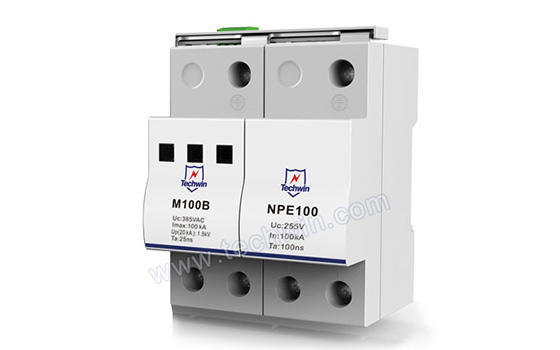With the continuous development of modern power systems, AC surge protection devices (SPD) are playing an increasingly important role in power systems. AC SPD can effectively protect electrical systems and equipment from transient voltages and surges, providing safety assurance for industrial, commercial, and residential applications. This article will explore the selection and application of AC SPD to help users better understand and use this critical device.

AC surge protection device (SPD) is a device connected to the AC (AC) network, designed to protect electrical systems and equipment by limiting transient voltages and diverting surge currents. Transient voltages and power surges pose significant risks to individuals and equipment, hence surge protection plays an important role in safety.
According to IEC standards, low-voltage power supply systems can be divided into TT, TN , and IT systems. The TN system is further divided into TN-C, TN-S, and TN-CSsystems. The appropriate SPD should be chosen based on the grounding method of the low-voltage power supply system. For example, in a TN AC power supply system, the distribution lines drawn from the main distribution box of the building must adopt the TN-S grounding method.
According to IEC 61643-11:2011 and EN 61643-11:2012+A11:2018 , AC SPD can be divided into three types:
Suitable for the main distribution equipment of buildings, the SPD 100kA rating is capable of withstanding direct lightning currents, providing robust protection for critical infrastructure.
Used to protect distribution equipment within the building.
Used to protect end equipment, usually installed near the equipment.
When selecting an SPD for AC power systems, the following basic considerations must be taken into account:
Determine whether the power supply is single-phase or three-phase.
Determine the voltage protection level of the SPD. The impulse withstand voltage of the protected electrical equipment should be greater than the voltage protection level UP of the SPD.
Ensure to select the correct number of ports or sockets.
Check if the SPD is a transient voltage surge protector and if it has the TUV mark.
It is crucial to choose SPD of the appropriate specification. If the SPD is chosen too large, the system will not be harmed but the cost will increase; if chosen too small, the system may fail faster.
Certified SPD typically includes fault indicators (such as indicator lights or signs), making it easy for maintenance personnel to determine whether the SPD is functioning properly. Regular inspection is necessary, and SPD devices with non-function indicators should be replaced as soon as possible.
The equipment used on industrial sites is very sensitive and prone to being affected by lightning and switching surges. Professional lightning and surge protection methods will ensure the long-term stable operation of industrial site equipment. By installing AC SPD on key equipment and distribution systems, equipment failures caused by surge voltages can be effectively reduced, thereby enhancing the safety and reliability of industrial production.
AC SPD plays an important role in protecting electrical systems and equipment from surge voltage damage. Through the reasonable selection and correct application of AC SPD, the safety and reliability of power systems can be greatly improved. If you have any questions or needs regarding the selection and application of AC SPD, feel free to contact Techwin.
 View of beautiful waterfall in Maluan Mountain in autumnOctober 21, 2022In order to enrich the cultural life of employees, under the organization of the Administration Department, We established "Techwin Outdoor Activities Team" mean to our employees to w...view
View of beautiful waterfall in Maluan Mountain in autumnOctober 21, 2022In order to enrich the cultural life of employees, under the organization of the Administration Department, We established "Techwin Outdoor Activities Team" mean to our employees to w...view Principles and Functions of a Surge Protector Against LightningDecember 12, 2024In modern industrial electrical systems, lightning and electromagnetic surges are common issues that can cause severe equipment damage. To guard against these electrical interferences, surge protector...view
Principles and Functions of a Surge Protector Against LightningDecember 12, 2024In modern industrial electrical systems, lightning and electromagnetic surges are common issues that can cause severe equipment damage. To guard against these electrical interferences, surge protector...view Is Surge Backup Protector the Same As Surge Protector?March 13, 20231.The Role of Surge Backup ProtectorBefore the advent of surge backup protectors, the backup protection devices of SPD surge protectors typically used fuses or circuit breakers to separate the short-c...view
Is Surge Backup Protector the Same As Surge Protector?March 13, 20231.The Role of Surge Backup ProtectorBefore the advent of surge backup protectors, the backup protection devices of SPD surge protectors typically used fuses or circuit breakers to separate the short-c...view The Principle of Surge Protector Lightning ProtectionSeptember 18, 2021The energy of lightning is huge, and lightning strikes can lead to casualties and property damage. With the development of technology, mankind has developed many lightning protection products to prote...view
The Principle of Surge Protector Lightning ProtectionSeptember 18, 2021The energy of lightning is huge, and lightning strikes can lead to casualties and property damage. With the development of technology, mankind has developed many lightning protection products to prote...view The IEC standards of SPDAugust 11, 2023IEC standards refer to the International Electrotechnical Commission standards, which are globally recognized and accepted guidelines for electrical and electronic devices. Spd stands for Surge Protec...view
The IEC standards of SPDAugust 11, 2023IEC standards refer to the International Electrotechnical Commission standards, which are globally recognized and accepted guidelines for electrical and electronic devices. Spd stands for Surge Protec...view Eco-Friendly Power: The Environmental Impact of SPD for Power SupplyJanuary 5, 2024In an era where environmental sustainability is a global priority, the deployment of Surge Protection Devices (SPDs) for power supply emerges as a crucial component in creating a greener and more resp...view
Eco-Friendly Power: The Environmental Impact of SPD for Power SupplyJanuary 5, 2024In an era where environmental sustainability is a global priority, the deployment of Surge Protection Devices (SPDs) for power supply emerges as a crucial component in creating a greener and more resp...view